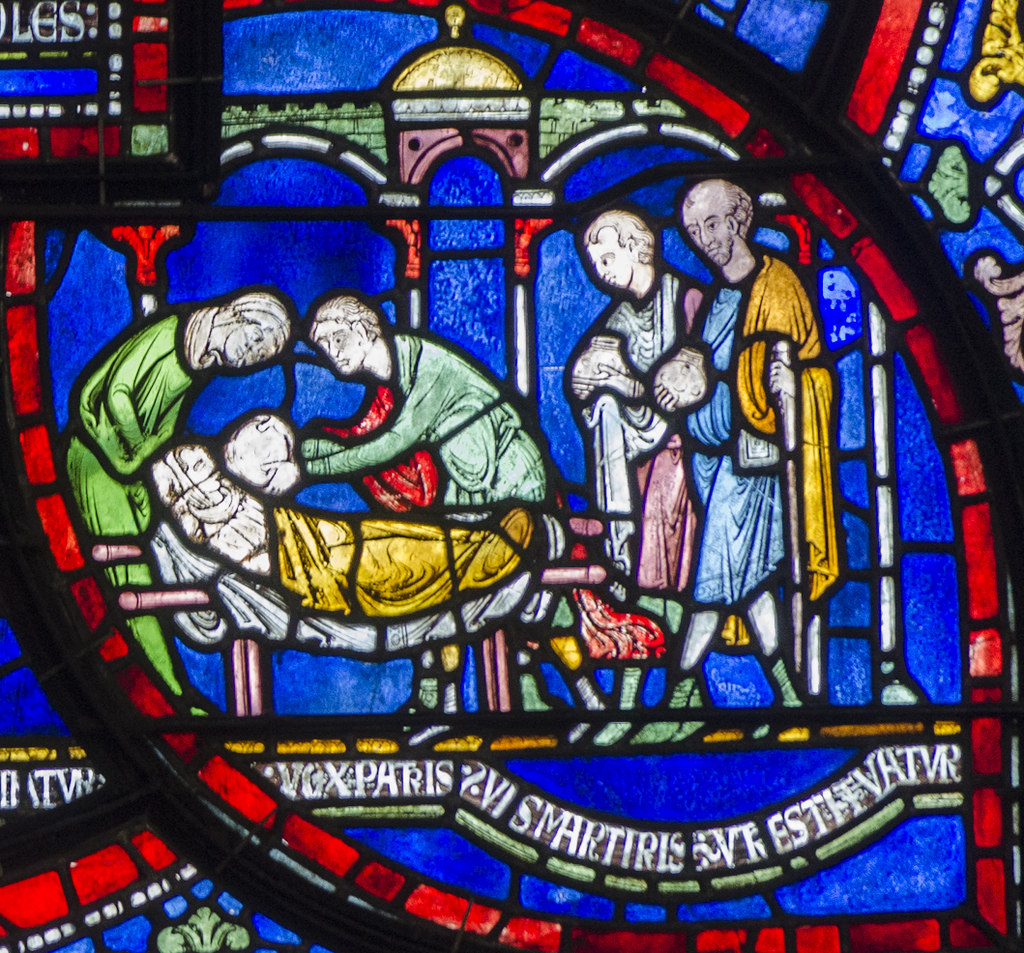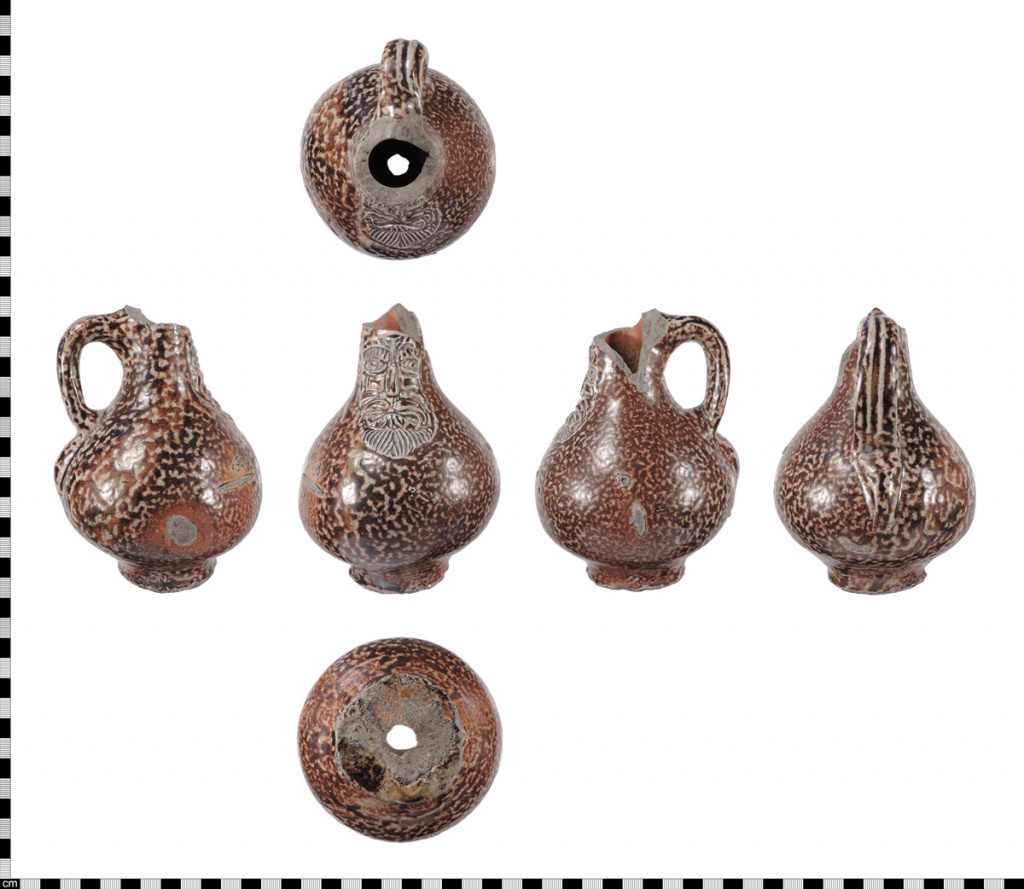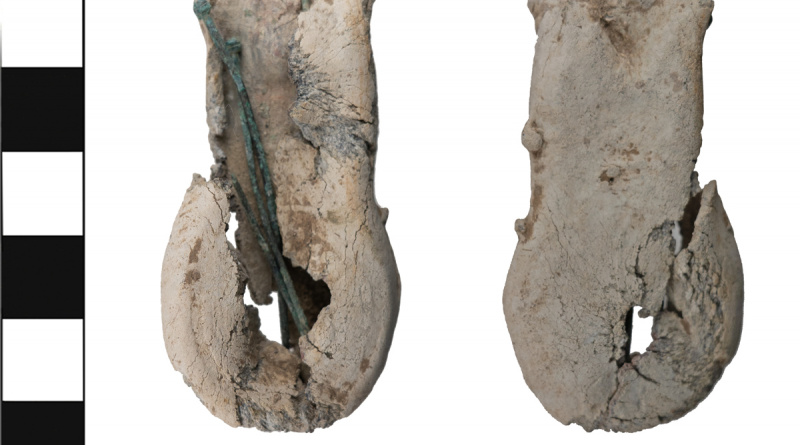Mystery of the pins in a pilgrims ampulla
This unusual find was recorded at the PAS last week as WMID-62DDD9. It’s a medieval pilgrims ampulla which contains pins. It is the first ampulla with pins to be recorded at the PAS and has been designated a Find of Note of County Importance.
What is the significance of the pins? The PAS record says “The presence of the pins is suggestive that the ampulla may have been treated like a ‘witch bottle’ although this would be an early example of one.” Sounds intriguing – I thought that a quick look at how ampullae and witch-bottles were used may shed some light on it.
Pilgrims ampulla
Detecting finds
Pilgrims ampulla used to be rare objects until they were dug up in their droves by detectorists. There are over 2000 recorded on the PAS with a handful being added each week. The frequency of these detecting finds, usually on cultivated land, supports the idea that they were used to bless fields.
Use of Pilgrims ampulla
Ampulla were popular from the late 12th to the early 16th century. They were purchased at the shrine of a saint, filled with some holy liquid. They were both a souvenir of the pilgrimage and an amulet to provide protection.

Just like today, trade was boosted by good reviews; Thomas Beckett had plenty. An example is this stained glass window from Canterbury Cathedral which depicts Sir Jordan Fitz-Eisulf reviving his son, who had died from the plague, with some “water of St Thomas“.
It was the liquid that gave the connection with the saint and transformed the ampulla into a holy object. The protection continued even after the liquid had been used. Therefore, as well as providing a cure for ills, ampulla also provided protection for property such as buildings and livestock; they would be hung in barns and stables and have been found in house foundations to protect from illness, disease and evil spirits.1
Witch Bottles
The use of witch bottles appears to have begun in the mid seventeenth century.2

Initially, the most common form of vessel was the Bellarmine jug or bottle, especially the type with a bearded mask on the shoulder.
A bottle could be filled with various items from the person needing protection, such as hair, nails or urine. Added in could be small bones, bits of wood, pieces of glass etc. However, by far the most common was iron pins or nails, which are found in 95% of witch bottles.
The idea being that if a witch had established a connection with you then by using your own hair and urine you could throw the spell back on them. The pins or nails would then cause them harm. One of the key points for a witch bottle to be successful was secrecy. Its power remained active as long as it was intact and remained hidden.
Tasting the contents
In a 2016 episode of Antiques Roadshow, glass specialist Andy McConnell speculated that a with bottle that had been brought in to the show might contain port or wine and so tasted a small amount. He noted the “rusty” flavour from the presence of nails. It was later analysed and shown to contain “urine, a tiny bit of alcohol, and one human hair“
Is this ampulla an early witch bottle?
There are a few things to consider:
1. Dates
The ampulla and the pins both date to about 1300 – 1500. However, witch-bottles start in the mid seventeenth century following the peak in witch trials from about 1560-1630 (Pendle witch trials were in 1612). That’s quite a gap if pin filled ampullae were a forerunner of the witch bottle. Also, of the hundreds of ampullae found, this appears to be the only known one with pins in it. If this were a common practice then similar finds would have been expected by now.
2. Christianity
Ampulla were directly connected to Christianity; they were bought at a pilgrimage site, filled with holy liquid and have been found in sacred spaces, for example mounted on communal prayer books. In medieval England, although there was some movement as time went on, mainstream Christian doctrine denied the existence of witches and witchcraft.
However, on the PAS website Simon Nicholson writes about Ampulla and graffiti. He notes the use of the same “so-called witch-marks ” found as graffiti in churches are also found on medieval ampullae.3 This supports the idea that ampullae were used to scare off witches.
3. Different strategies
The ampulla and the witch-bottle have different strategies. The ampulla was inextricably linked with the associated saint. It was he or she that provided the protection. It’s not clear how adding pins would provide more protection. In contrast, the witch-bottle was very much linked to the person under threat. The protection was gained by sending the spell back and causing harm to the witch. Hence, the need for the pins or nails.
4. Expert view
I contacted Brian Hoggard, author of Magical House Protection: The Archaeology of Counter-Witchcraft and www.apotropaios.co.uk for his view. He said “This ampulla does have the pins, one broken, one bent and one whole so could have been a protective charm yes, but not the same as a witch-bottle.“
Mundane explanation
I think at times there can be a temptation to reach for an exotic explanation when unusual artefacts are found when a more mundane one would fit just as well.
Although there is no definitive evidence, some believe that ampullae were nailed to buildings to provide protection. This find could just be a ham-fisted attempt to do just that; three nails were accidently dropped into the ampulla during the process and, not wishing to damage it in trying to retrieve them, they were left there.
As always, pleased to receive and opinions or comments.
References

